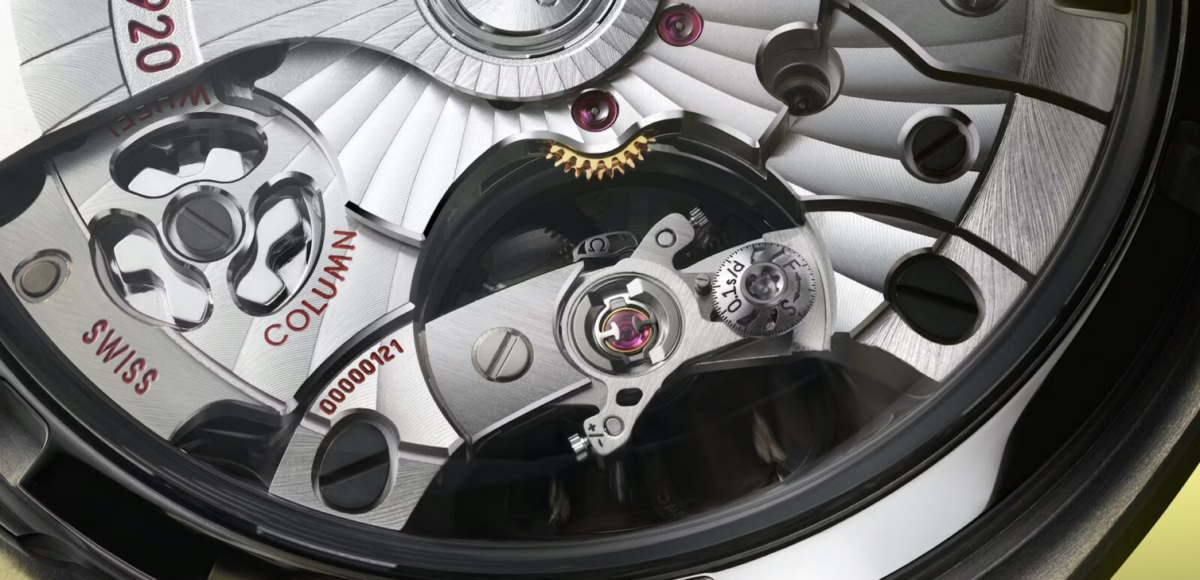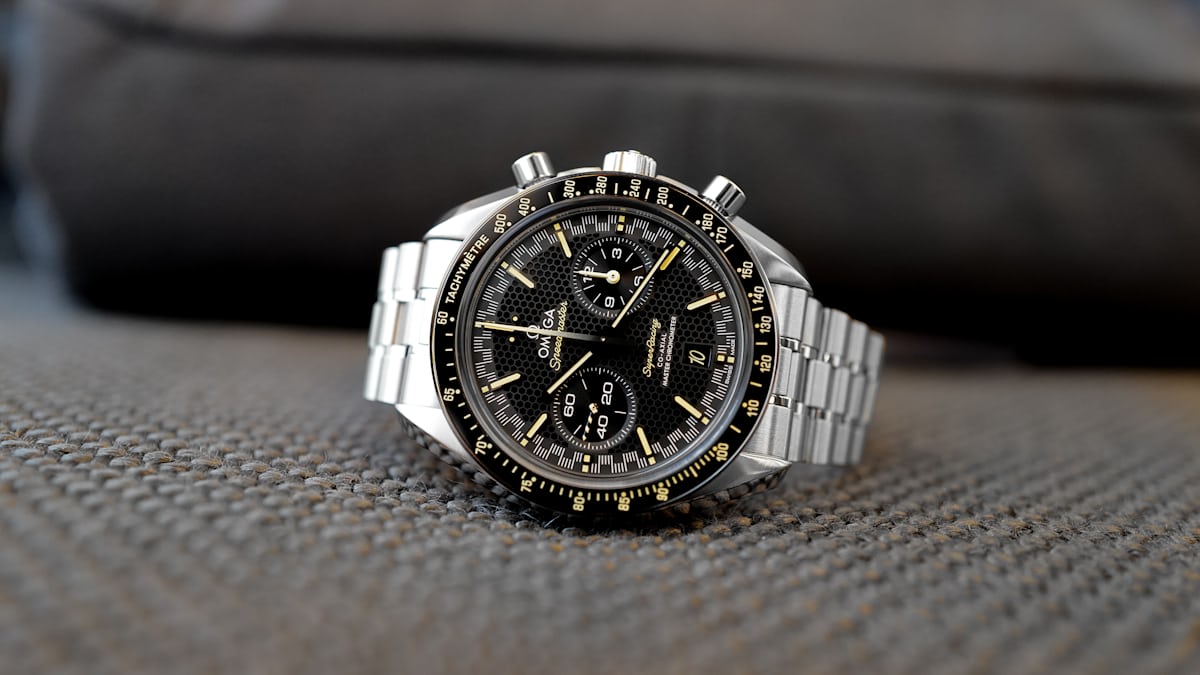Here’s How The New Omega Spirate System Works
We asked our head watchmaker to explain Omega’s new Spirate System – here’s why he said it’s ‘absolutely brilliant.’
A couple weeks ago, Omega announced the new Speedmaster Super Racing, but the more exciting bit of news was the technical innovation inside, the new Spirate System. Omega says the new mechanism will allow it to regulate the movement to 0/+2 seconds per day. Eventually, Omega plans to industrialize the Spirate System and roll it out across other models.
As a simple watch writer and non-watchmaker, I decided to call up Hodinkee’s Technical Manager – around here, we just call him our “head watchmaker” – Travis Hines, to help me understand the new Spirate System. To understand why the new tech is such an exciting development, we walked it back to the beginning and what it means to regulate a watch and the traditional methods of regulation before getting to how the Spirate System is an improvement on these approaches.
First, we need to start with what it means to regulate a watch.
“Regulating a watch simply means changing the rate at which the balance wheel is oscillating back and forth,” Hines explained. This is typically done by changing the “active length” of the hairspring, which changes how much the balance wheel that’s attached to the hairspring can rotate before the power of the spring pulls it back in the other direction. “By regulating, we increase or decrease the length of the hairspring to either speed it up to cause the watch to beat faster or slow it down to cause it to beat slower.”
Today, there are two common methods of regulating a watch.
“The first common way that you’ll see regulation is with the use of index pins,” Hines said. “This is still widely used in the industry today. Most commonly, two index pins are used to straddle the hairspring, and as you move the indexing arm up and down, it shortens or lengthens the active length of the hairspring that works on the balance wheel. Traditionally, this is the easiest way to regulate a watch.”
The other common method of regulation is free-sprung, which is what you see in Rolex’s Microstella system and Patek’s Gyromax system. This means that the spring has no regulating pins. “Instead, we rely on weights or screws on the balance wheel itself to regulate the beat,” Hines said. “Think of the weights on the balance wheel like a figure skater: When you see a figure skater pull their arms in, they go faster, and then as their arms go out they slow down. We’re doing the same thing with the little screws on the rim of the balance. As we move the weight in toward the center of the balance wheel, it speeds up, which means it’s going to gain more time. And as we move that weight out, it’s going to slow down.”
Ok but what does that have to do with Omega? What balance wheel does it use?
Omega introduced its Si14 silicon hairspring in 2008, as other manufacturers also transitioned to silicon for its benefits compared to traditional alloys like Nivarox, such as better anti-magnetism and temperature resistance. Since then, Omega has relied on free-sprung regulation of its hairsprings. But this can be difficult.
“The biggest problem with this is that when changing the weight you have to be hyper-precise,” Hines said. “If you’re off by even a fraction of a millimeter, it’s going to impact the rate drastically because now you’ve got a heavier weight on one side. With the new Spirate System, my speculation is that the balance will be preset by the factory and then you’ll use the hairspring regulating system for adjustments.”
The Spirate System works by attaching a flexible “blade” to the hairspring that can be easily adjusted to affect the stiffness of the hairspring.
The Spirate System attaches a flexible blade to the hairspring (the thin piece underneath the Omega logo), which attaches to the hairspring and has a long “tail” that attaches to the balance bridge, where it can then be adjusted.
The Spirate System takes Omega’s standard silicon hairspring and attaches to it a flexible blade, from which extends a long “tail” that attaches to the balance bridge. This attachment point can then be adjusted by a snail cam (it looks like a screw in the image below). The key to understanding Spirate is in understanding how this flexible blade works: tension can be added or removed from this blade, which is connected to the hairspring and thus acts to adjust the stiffness of the hairspring.
Here’s how that works.
The Spirate System is circled in red in the diagram above. The red and green arrow point at the blade that acts on the hairspring. You can see two elements attached to the bottom of this blade. The first, thicker attachment is the hairspring. The second, thinner “tail” curves around to attach to a “regulating arm” (with the “+/-” engraved), then continues to curve up and attaches to the balance bridge (under the snail cam engraved “0.1 s/d”).
According to Hines, it seems that the regulating arm and the snail cam allow for regulation of the hairspring: the regulating arm can be directly adjusted for larger adjustments, while the snail cam allows for the micro-adjustment to 1/10th of a second that Omega’s touting, allowing for regulation to 0/+2 per day. When you adjust the attachment point of the Spirate System’s tail on the balance bridge, the tail pushes or pulls on the flexible blade, adding or removing tension. Since the blade is attached to the hairspring, this then acts on the hairspring. For example, pushing on the blade by adjusting the tail’s attachment point closer will increase tension in the blade, then causing the hairspring to increase in stiffness, causing it to beat faster.
The snail cam allows for such small incremental adjustments that a watchmaker would never be able to replicate by hand using traditional regulation methods. That scale on the outside of the cam isn’t just for show – it’s to help guide adjustments.
“This is the part that I find very exciting because I love to see new innovations,” Travis said. “Omega has essentially created a third type of regulating system where instead of changing the weight on the balance or using index pins, they’re actually adjusting the stiffness of the balance spring itself. So as the spring gets stiffer, it’s going to cause the balance to run faster and as it loosens up, it’ll run slower.”
The Spirate System represents an improvement over Omega’s current method of regulating its movements, for both Omega and its customers.
According to Hines, the current method of adjusting the weights on the balance wheel to regulate a watch is a pain point for Omega. Not only is one of the most common complaints for customers that their watch is gaining or losing time, but it’s cumbersome to make adjustments by tweaking the weights on the balance wheel. It’s difficult to get just right, requires using big tools, and if you accidentally knick the hairspring and it snaps, then you have to replace the entire balance mechanism.
“I think this is actually significantly better for the boutiques now, with these regulating points away from anything that you could accidentally hit.” With Spirate, Omega has made adjustment and regulation easy enough that anyone can be trained on it at a boutique, with minimal risk to the watch itself (in particular to the hairspring).
Omega’s Spirate System could represent a huge leap forward for mechanical watchmaking accuracy.
While Omega introduced the Spirate System in the new Speedmaster Super Racing, it says it’ll be able to industrialize the manufacturing process, eventually rolling it out across its movements. If Omega’s able to do this and the system works as expected, Hines says it’s a huge technological leap forward for timekeeping.
“I would put this almost on par with moving away from the traditional blue steel hairspring to using a Nivarox alloy,” Hines said, referring to the transition by manufacturers in the early-20th century from steel to Nivarox hairsprings, a more temperature- and magnetic-resistant alloy. “That was a huge jump forward in accuracy and combating magnetism. I’d consider [the Spirate System] to be a bigger jump than Omega’s 2008 move from Nivarox alloy hairsprings to silicon hairsprings because this is an entirely new regulating principle.”
“I think it’s absolutely brilliant. I can’t stress that enough. It’s exciting to see an innovation that adds a whole new layer to a field that doesn’t change drastically.”
Your move, competitors.
Now, for the elephant in the accuracy room. Since 2014, Omega’s rolled out its Master Chronometer certification across its models. To be a Master Chronometer, Omega’s movements are COSC-certified, then they’re cased up and put through a series of eight METAS tests, mostly focused on anti-magnetism and accuracy. It’s already a unique combination of independent testing that Omega’s competitors (mostly) don’t offer – Rolex’s internal “Superlative Chronometer” certification touts accuracy of +/-2 seconds per day (James took us inside Rolex to better explain its Superlative Chronometer testing here). The Spirate System takes Omega’s certification a step forward, promising accuracy of 0/+2 seconds per day.
“With this announcement, any brand that’s looking to compete in terms of accuracy – Rolex and Zenith come to mind – I’m sure is already looking into ways to replicate something similar to the Spirate System,” Hines said.
Get More Articles Like This in Your Inbox
We're constantly creating great content like this. So, why not get it delivered directly to your inbox? By subscribing you agree to our Privacy Policy but you can unsubscribe at any time.












